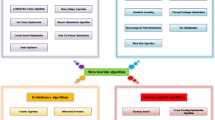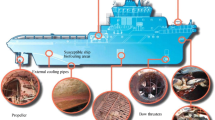Abstract
The development of bio-inspired aquatic robots for underwater operations and scientific research has dramatically improved over the past decades. Dynamic modelling of such robots relies on the reactive force produced through the physical movement of their body parts. It is highly complex to capture the complete hydrodynamics for defining the reactive force, making the modelling and control of robotic fish challenging. This paper captures the hydrodynamic parameters from real-time data using a grey-box model structure optimized by a genetic algorithm (GA). The GA-optimized model aligns with real-time experimentation, exhibiting an average mean square error of approximately 0.001 m2 across six swimming speeds. Next, GA optimization is proposed for designing the fuzzy logic controller to control the speed of the robotic fish. GA adjusts the parameters of the membership function and minimizes the error function. Finally, the controller’s performance is compared with the classical GA-tuned PID (GAPID) and conventional fuzzy logic controller (FLC). The proposed controller has significant improvement in terms of tracking error, integral square error (ISE), integral absolute error and integral time absolute error. The optimized controller has achieved an ISE improvement of 84.64% and 87.15% compared to FLC and GAPID controllers, respectively.















Similar content being viewed by others
References
Wang J, Tan X (2013) A dynamic model for tail-actuated robotic fish with drag coefficient adaptation. Mechatronics 23:659–668. https://doi.org/10.1016/j.mechatronics.2013.07.005
Porez M, Boyer F, Ijspeert AJ (2014) Improved lighthill fish swimming model for bio-inspired robots: modeling, computational aspects and experimental comparisons. Int J Rob Res 33:1322–1341. https://doi.org/10.1177/0278364914525811
Duraisamy P, Kumar Sidharthan R, Nagarajan Santhanakrishnan M (2019) Design, modeling, and control of biomimetic fish robot: a review. J Bionic Eng 16:967–993. https://doi.org/10.1007/s42235-019-0111-7
Colgate JE, Lynch KM (2004) Mechanics and control of swimming: a review. IEEE J Ocean Eng 29:660–673. https://doi.org/10.1109/JOE.2004.833208
Verma S, Xu JX (2017) Data-assisted modeling and speed control of a robotic fish. IEEE Trans Ind Electron 64:4150–4157. https://doi.org/10.1109/TIE.2016.2613500
Suebsaiprom P, Lin CL (2015) Maneuverability modeling and trajectory tracking for fish robot. Control Eng Pract 45:22–36. https://doi.org/10.1016/j.conengprac.2015.08.010
Hamamci S, Korkmaz D, Akpolat ZH et al (2015) Dynamic simulation model of a biomimetic robotic fish with multi-joint propulsion mechanism. Trans Inst Meas Control 37:684–695. https://doi.org/10.1177/0142331214565710
Chowdhury AR, Sasidhar S, Panda SK (2016) Bio-harmonized control experiments of a carangiform robotic fish underwater vehicle. Adv Robot 30:338–351. https://doi.org/10.1080/01691864.2015.1114905
Zhou C, Cao Z, Hou ZG et al (2013) Backward swimming gaits for a carangiform robotic fish. Neural Comput Appl 23:2015–2021. https://doi.org/10.1007/s00521-012-1106-z
Wang J, Tan X (2015) Averaging tail-actuated robotic fish dynamics through force and moment scaling. IEEE Trans Robot 31:906–917. https://doi.org/10.1109/TRO.2015.2433539
Zuo W, Dhal K, Keow A et al (2020) Model-based control of a robotic fish to enable 3D maneuvering through a moving orifice. IEEE Robot Autom Lett 5:4719–4726. https://doi.org/10.1109/LRA.2020.3003862
Ren Q, Xu J, Li X (2015) A data-driven motion control approach for a robotic fish. J Bionic Eng 12:382–394. https://doi.org/10.1016/S1672-6529(14)60130-X
Niu X, Xu J, Ren Q, Wang Q (2013) Locomotion generation and motion library design for an anguilliform robotic fish. J Bionic Eng 10:251–264. https://doi.org/10.1016/S1672-6529(13)60221-8
Verma S, Xu JX (2018) Analytic modeling for precise speed tracking of multilink robotic fish. IEEE Trans Ind Electron 65:5665–5672. https://doi.org/10.1109/TIE.2017.2779431
Li X, Ren Q, Xu JX (2016) Precise speed tracking control of a robotic fish via iterative learning control. IEEE Trans Ind Electron 63:2221–2228. https://doi.org/10.1109/TIE.2015.2499719
Yu J, Yuan J, Wu Z, Tan M (2016) Data-Driven Dynamic modeling for a swimming robotic fish. IEEE Trans Ind Electron 63:5632–5640. https://doi.org/10.1109/TIE.2016.2564338
Yang L, Chen G, Rytter NGM et al (2019) A genetic algorithm-based grey-box model for ship fuel consumption prediction towards sustainable shipping. Ann Oper Res. https://doi.org/10.1007/s10479-019-03183-5
Wang W, Gu D, Xie G (2017) Autonomous optimization of swimming gait in a fish robot with multiple onboard sensors. IEEE Trans Syst Man Cybern Syst 49:891–903. https://doi.org/10.1109/TSMC.2017.2683524
Esfahani MA, Karbasian HR, Kim KC (2019) Multi-objective optimization of the kinematic parameters of fish-like swimming using a genetic algorithm method. J Hydrodyn 31:333–344. https://doi.org/10.1007/s42241-018-0160-0
Yu J, Wu Z, Wang M, Tan M (2016) CPG Network optimization for a biomimetic robotic fish via PSO. IEEE Trans Neural Netw Learn Syst 27:1962–1968. https://doi.org/10.1109/TNNLS.2015.2459913
Zhong G, Wang C, Dou W (2021) Fuzzy adaptive PID fast terminal sliding mode controller for a redundant manipulator. Mech Syst Signal Process. https://doi.org/10.1016/j.ymssp.2020.107577
Yilmaz BM, Tatlicioglu E, Savran A, Alci M (2021) Adaptive fuzzy logic with self-tuned membership functions based repetitive learning control of robotic manipulators. Appl Soft Comput 104:107183. https://doi.org/10.1016/j.asoc.2021.107183
Wen L, Wang T, Wu G et al (2012) Novel method for the modeling and control investigation of efficient swimming for robotic fish. IEEE Trans Ind Electron 59:3176–3188. https://doi.org/10.1109/TIE.2011.2151812
Yu J, Liu J, Wu Z, Fang H (2018) Depth control of a bioinspired robotic Dolphin based on sliding-mode fuzzy control method. IEEE Trans Ind Electron 65:2429–2438. https://doi.org/10.1109/TIE.2017.2745451
Yu J, Sun F, Xu D, Tan M (2016) Embedded vision-guided 3-D tracking control for robotic fish. IEEE Trans Ind Electron 63:355–363. https://doi.org/10.1109/TIE.2015.2466555
Yu J, Tan M, Wang S, Chen E (2004) Development of a biomimetic robotic fish and its control algorithm. IEEE Trans Syst Man Cybern Part B Cybern 34:1798–1810. https://doi.org/10.1109/TSMCB.2004.831151
Ramasamy V, Sidharthan RK, Kannan R, Muralidharan G (2019) Optimal tuning of model predictive controller weights using genetic algorithm with interactive decision tree for industrial cement kiln process. Processes 7:938. https://doi.org/10.3390/PR7120938
Raj A, Thakur A (2016) Fish-inspired robots: design, sensing, actuation, and autonomy—a review of research. Bioinspir Biomimet 11:031001. https://doi.org/10.1088/1748-3190/11/3/031001
Lighthill MJ (1960) Note on the swimming of slender fish. J Fluid Mech 9:305–317. https://doi.org/10.1017/S0022112060001110
McMasters RL, Grey CP, Sollock JM et al (2008) Comparing the mathematical models of lighthill to the performance of a biomimetic fish. Bioinspir Biomimet 3:016002. https://doi.org/10.1088/1748-3182/3/1/016002
Duraisamy P, Nagarajan Santhanakrishnan M, Rengarajan A (2023) Design of deep reinforcement learning controller through data-assisted model for robotic fish speed tracking. J Bionic Eng 20:953–966. https://doi.org/10.1007/s42235-022-00309-7
Duraisamy P, Santhanakrishnan MN (2021) Hydrodynamic modeling and design of robotic fish using slender body theory. IOP Conf Ser Mater Sci Eng. https://doi.org/10.1088/1757-899x/1012/1/012007
Xiang X, Yu C, Zhang Q (2017) Robust fuzzy 3D path following for autonomous underwater vehicle subject to uncertainties. Comput Oper Res 84:165–177. https://doi.org/10.1016/j.cor.2016.09.017
Pakdaman M, Effati S (2016) Approximating the solution of optimal control problems by fuzzy systems. Neural Process Lett 43:667–686. https://doi.org/10.1007/s11063-015-9440-7
Katoch S, Chauhan SS, Kumar V (2021) A review on genetic algorithm: past, present, and future. Multimed Tools Appl 80:8091–8126. https://doi.org/10.1007/s11042-020-10139-6
Borase RP, Maghade DK, Sondkar SY, Pawar SN (2020) A review of PID control, tuning methods and applications. Int J Dyn Control 9:818–827. https://doi.org/10.1007/s40435-020-00665-4
Hui T, Zeng W, Yu T (2020) Core power control of the ADS based on genetic algorithm tuning PID controller. Nucl Eng Des 370:110835. https://doi.org/10.1016/j.nucengdes.2020.110835
Funding
The authors did not receive support from any organization for the submitted work.
Author information
Authors and Affiliations
Contributions
Conceptualization, Methodology, Writing - original draft (PD); Writing - review and editing, Validation, Supervision (MNS); Formal Analysis, Visualization, Supervision (RA); All authors reviewed the manuscript.
Corresponding author
Ethics declarations
Conflict of Interest
The authors have no relevant conflicts of interest to disclose.
Ethical Approval
This article does not contain any studies with human participants or animals performed by any authors.
Additional information
Publisher’s Note
Springer Nature remains neutral with regard to jurisdictional claims in published maps and institutional affiliations.
Rights and permissions
Springer Nature or its licensor (e.g. a society or other partner) holds exclusive rights to this article under a publishing agreement with the author(s) or other rightsholder(s); author self-archiving of the accepted manuscript version of this article is solely governed by the terms of such publishing agreement and applicable law.
About this article
Cite this article
Duraisamy, P., Santhanakrishnan, M.N. & Amirtharajan, R. Genetic Algorithm Optimized Grey-Box Modelling and Fuzzy Logic Controller for Tail-Actuated Robotic Fish. Neural Process Lett 55, 11577–11594 (2023). https://doi.org/10.1007/s11063-023-11391-1
Accepted:
Published:
Issue Date:
DOI: https://doi.org/10.1007/s11063-023-11391-1




